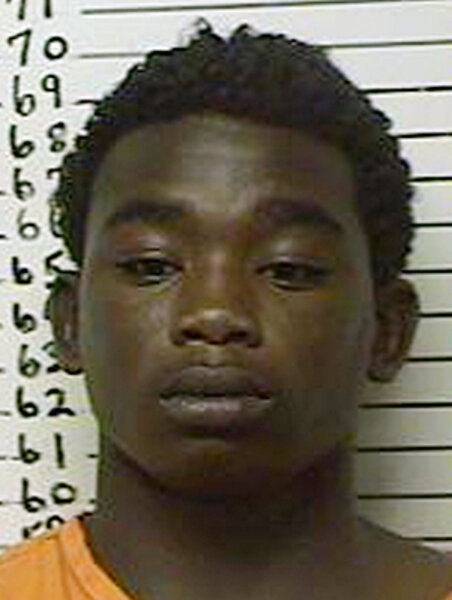Was Chicago rapper inspiration for 'bored' killing in Oklahoma?
Loading...
| Chicago
As new details emerge about the Oklahoma teenager accused of the random murder of a student athlete last week, it is becoming apparent he was an active enthusiast of a Chicago rapper police say is linked to gang violence in the city.
James Edwards is accused by police of shooting Christopher Lane in the back last Friday while Mr. Lane, a baseball player from Australia, was jogging in Duncan, Okla. Mr. Edwards allegedly told police he targeted Mr. Lane “for fun” and because he was “bored.” There appears to be no link between both men.
“We were bored and didn't have anything to do, so we decided to kill somebody,” police say Edwards told them, according to the Associated Press. He is currently being held without bond.
Edwards and Chancey Luna, one of three teenagers involved in targeting Lane, have been charged with first-degree murder and will be tried as adults. Michael Jones, the driver of their car, is being held on $1 million bond and has been charged with accessory to first-degree murder and using a vehicle in the discharge of a weapon.
The senseless killing is forcing a deeper scrutiny into what little is known about Edwards. Soon after his arrest, media accounts focused on statements made in a Twitter feed attributed to his name that suggested he was planning to kill someone.
However, several of those statements are, in fact, lyrics from Chicago rap star Chief Keef, whose real name is Keith Cozart.
Mr. Cozart, who is also a teenager, released a debut album on Interscope Records late last year, but is more widely known for his troubles with police. In March, Cozart was released from juvenile detention for violating the probation he received after pointing a gun at Chicago police officers in 2011.
Cozart is the biggest star of “drill music,” a slang term for retaliation and a new style of rap music that is darker and infused with voyeuristic tales invoking violence. It features artists who were largely discovered, and subsequently promoted, via social media.
Police say drill artists have links to street gang factions that they blame for recent spikes in homicides; for example, they say Cozart is a member of a faction of the Black Disciples gang in Chicago that they have tried to link to several high-profile killings on the city’s South Side last year.
Lance Williams, a professor of inner-city studies at Northeastern Illinois University in Chicago, says drill music is attractive for disenfranchised youth to establish an identity that gives them power. This is true for both the artists and the fans, neither of whom may actually be in a gang, but who may glorify the life to “gain status” because they have little or no exposure to other alternatives.
The glorification of gang life is evident in the Oklahoma shooting. Jennifer Luna, the mother of Chancey, told the CBS affiliate in Oklahoma City Thursday that her son and his friends behaved as if they were in a “wannabe gang.”
“Because music is at the center of the formation of cultural identity for marginalized youth, it’s very powerful,” Professor Williams says. “So now you have kids growing up listening to the music and feeling that the music is expressing who they are as young, African-American males. This is bigger than participating in a gang. It is the core of your value system.”
From published quotes, videos, and statements on the Twitter feed attributed to Edwards, it appears the author is actively immersed in drill music culture.
While there are quotes from other drill artists such as Gucci Mane and Lil Durk, they largely are sourced from songs by Chief Keef. The feed also publishes several tweets directed to Cozart’s official Twitter account.
One tweet, published three days before the killing, quotes “I Don’t Like,” Cozart’s most popular song: “With my [expletive] when it’s time to start taking lives.” Another, taken from the song “O’Block 4 Life” and published in late July, features the lyrics “I’ll take yo life! No talk no fight.”
The day before the killing, the feed published a tweet directed to Cozart that says, “up early trying to get that almighty SOSA! We do this [expletive] early down South.” Sosa is both Cozart’s nickname and a slang term for smoking cocaine.
For several months, the Twitter feed also published Cozart videos and tweets directed to the rapper’s Twitter account. The tweets tell followers about the rapper’s birthday, and heap praise directly on Cozart himself.
Teenagers are using social media to create identities that are warped from their own, says Mark Anthony Neal, a professor of African-American Studies at Duke University in Durham, N.C., and the author of “Looking for Leroy: Illegible Black Masculinities” (NYU Press).
“For kids under 18 using social media, there is no alternative. This is what you do with it. There is an element of performance that says ‘this is who I want the world to see me as,’ and social media allows them to do that,” Professor Neal says.
The cultural, economic, and social divide between rural Oklahoma and the South Side of Chicago may be wide, but social media has “closed that gap,” he says.
“Swagger is something you personally cultivate in how you present yourself out to the world … so even if you’re in Oklahoma, social media allows you to be an authority about this kind of lifestyle,” he says.








